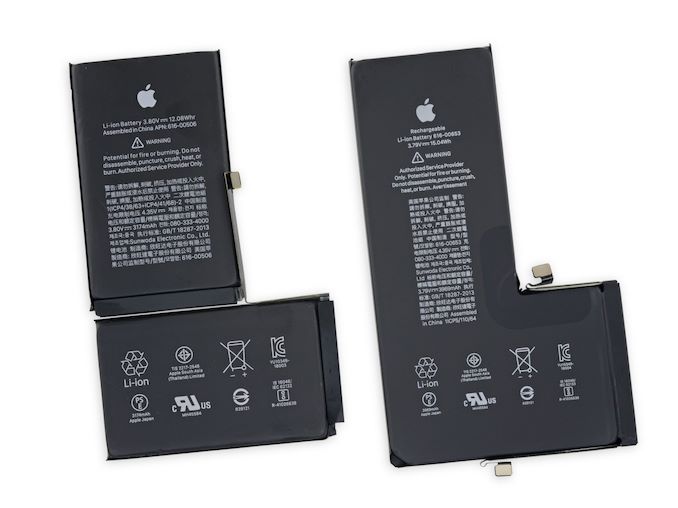The Apple iPhone 11, 11 Pro & 11 Pro Max Review: Performance, Battery, & Camera Elevated
by Andrei Frumusanu on October 16, 2019 8:30 AM ESTBattery Life - A Magnitude Shift
By now many will have heard positive things about the new iPhone 11s' battery life. As we have covered in the introduction, possibly the biggest changes to Apple’s line-up this year is the device’s vastly increased battery capacities. The Pro models in particular have seen significant increases: the 11 Pro gets a 3046mAh battery which represents a 14.5% increase compared to the XS, and the 11 Pro Max gets a 3969mAh battery which represents a very large 25% increase. The Pro Max is now the first Apple device which has a battery capacity comparable to Android phones out there, some of which have offered similar large capacities for a few years now.

iPhone XS Max vs. iPhone 11 Pro Max Batteries (Image Courtesy iFixit)
The regular iPhone 11 sees only a 5.7% bump to up to 3110mAh, which isn’t all that big upgrade compared to the XR. But it also doesn’t increase its weight nearly as much as the Pro models.

The battery results in our web test are outstanding. Apple in this generation has gone from being average in battery life to showcasing some of the best results we’ve seen in the market.
What is very interesting here is how our absolute test runtimes end up compared to Apple’s marketing claims. Apple has promised +1H, +4H and +5H of battery life for the 11, 11 Pro and the 11 Pro Max compared to their predecessors, and what we measured is 1.08H, 3.9H and 5.27H, which is pretty damn near Apple’s promoted figures, pointing out to some very similar testing conditions between our test and Apple’s internal metrics.
If we break this down a bit and theorize a bit, if we take the XS Max 10.31H result, multiply by 1.25x for the increased battery capacity (12.88H), multiply again naively by 1.15x for the more efficient screen (14.82H), we’re left with a ~5% margin which would account for the more efficient SoC. Give or take margin of error here or there, the results we’re seeing shouldn’t be all too surprising. The math would also check out for the iPhone 11 without a newer display: 5% increased battery capacity and an on average ~3% more efficient SoC.
There’s not much to say about the new iPhone 11 series' battery life other than it's exemplary. More importantly, Apple has managed to finally catch up and exceed the battery life of the LCD iPhone 8 and Plus models from 2 years ago.










242 Comments
View All Comments
FunBunny2 - Thursday, October 17, 2019 - link
"I wonder which workloads can it possibly affect."lots and lots of software fake floating point arithmetic by scaling integer arithmetic. way faster, even counting the need to shift the decimal point.
MrCommunistGen - Wednesday, October 16, 2019 - link
Bravo Andrei and team! Technical acumen in the article top notch as usual.I'm quite happy with the improvements to writing/editing that have happened over the past year(s?). In this piece the writing was clear to understand almost entirely throughout. In the past, although I was always able to discern the meaning and intent of the content it was sometimes a struggle.
As for the iPhones themselves: Apple's technical silicon expertise does not cease to amaze me. Their absolute performance as well as efficiency are incredible. I'm not sure that this level of excellence is possible on the Android side of things. Since Apple is vertically integrated they're not nearly as constrained on die size as companies who are consumers of ARM's chip designs. Also, they've clearly made an enormous investment in their SoC team, not just financially, but in expertise as well as effective inter/intra team collaboration.
It is somewhat deflating to see that in many metrics the Snapdragon 855 is only on par with the A10 SoC from the iPhone 7. As someone likely looking for a 2020 Android device, I have more than a little silicon envy -- and the reasonable (in today's market at least) price of the base iPhone 11 makes it quite compelling compared to Android flagships.
jrs77 - Wednesday, October 16, 2019 - link
Now make it as small as an iPhone SE and you might have another customer. I'm not buying a phone that I can't even carry in my trousers pockets.yetanotherhuman - Wednesday, October 16, 2019 - link
The 3 camera layout is more than ugly, though, it's actually revolting. As in, it invokes disgust.Xyler94 - Thursday, October 17, 2019 - link
It's a good thing you view the phone from the front about 95% of the time, huh? :)anonomouse - Wednesday, October 16, 2019 - link
Andrei, is the power/voltage curve for the A12 charting power on the CPU rail only, or for the whole system? Since the voltage is presumably just the CPU power rail.Andrei Frumusanu - Wednesday, October 16, 2019 - link
Total system active power, only the top point is measured, the rest is inferred/approximated. It's not exact but it's not meant to be, the point was to show that the CPU gets a lot more efficient at slightly lower clocks.anonomouse - Wednesday, October 16, 2019 - link
Presumably a lot of that total system power is coming from DRAM/SoC though, so that part wouldn't scale the same way/at all with CPU voltage. Not trying to debate the point that the CPU will absolutely be more efficient below that, but the steepness of the system power curve would be probably be less steep.anonomouse - Thursday, October 17, 2019 - link
Also, did you ever get a chance to measure how large the power efficiency improvements the Exynos 9825 on 7LPP had (CPU/GPU) as compared to the 9820?Andrei Frumusanu - Thursday, October 17, 2019 - link
I still don't have an 9825. Generally the consensus seems to be 15%.